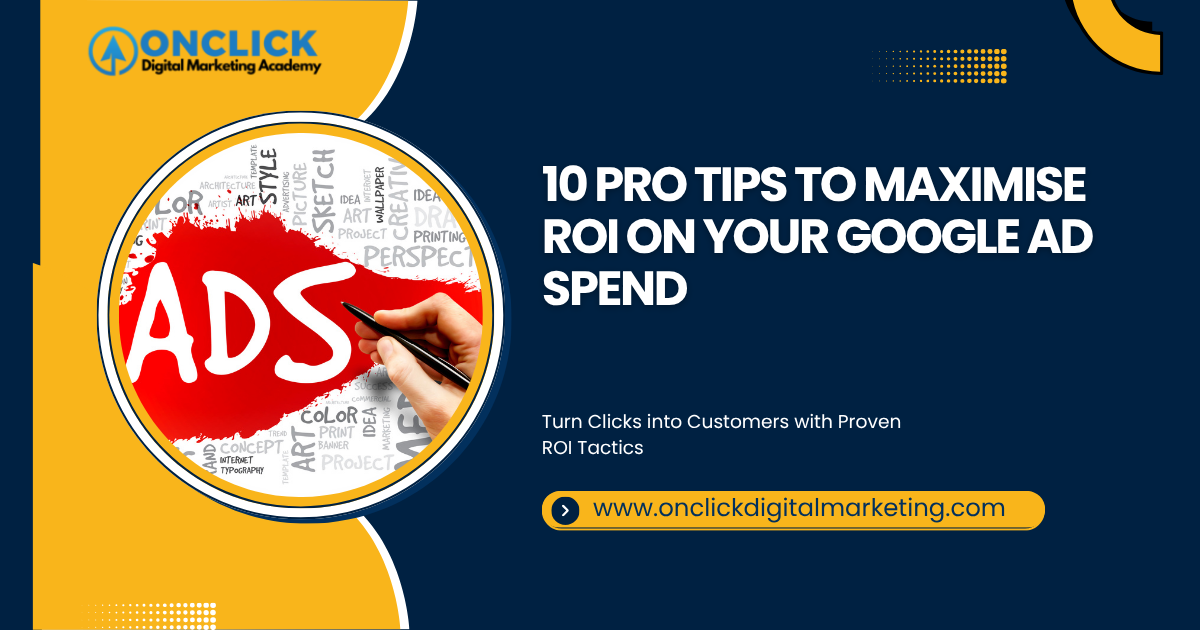- 9985023500 | 9346775340
- onclickhyderabad@gmail.com
- Abids | Ameerpet | Dilsukhnagar | Kukatpally

When it comes to online advertising, Google Ads is one of the most powerful platforms available. But with rising competition and increasing costs per click, simply running ads isn’t enough. If you want to see real returns on your investment, you need a strategy that’s built around performance and efficiency.
In this blog, we’ll explore 10 pro tips to help you maximize the ROI (Return on Investment) on your Google Ad spend—whether you’re a small business owner, marketer, or digital agency professional.
Before launching any campaign, ask yourself: What do I want to achieve? It could be lead generation, online sales, brand awareness, or app installs. Your campaign settings, ad creatives, and landing pages should align with these goals.
A clear objective ensures every rupee you spend is targeted toward a measurable outcome.
Not all keywords are equal. Targeting high-intent, transactional keywords like “buy,” “book now,” or “best [product/service] near me” increases your chances of attracting users who are ready to convert.
Use tools like Google Keyword Planner, SEMRush, or Ubersuggest to find keywords with commercial intent and optimize your bidding strategy around them.
A common cause of budget wastage is irrelevant clicks. By adding negative keywords, you can prevent your ads from showing up for irrelevant search queries.
For example, if you sell premium furniture, adding “cheap” or “DIY” as negative keywords can help eliminate unqualified traffic.
Single Keyword Ad Groups (SKAGs) are a powerful way to improve your ad relevance. Each ad group contains only one keyword, which allows you to write highly specific ad copy that improves CTR and Quality Score, ultimately lowering your Cost-Per-Click (CPC).
Sending users to your homepage or a generic page is a mistake. Instead, create dedicated landing pages that match the ad copy and keyword intent.
Make sure your landing pages are:
Fast loading
Mobile-friendly
Clear in messaging
Equipped with a strong call-to-action (CTA)
High-performing landing pages can double or even triple your conversion rates.
You can’t optimize what you don’t measure. By enabling Google Ads conversion tracking or linking with Google Analytics, you can see exactly which campaigns, ad groups, and keywords are driving results.
This data is crucial for eliminating underperforming ads and investing more in what works.
Ad extensions make your ads larger and more informative. They not only increase CTR but also provide users with more paths to engage.
Popular ad extensions include:
Sitelinks – Direct users to specific pages
Callouts – Highlight key offers or features
Structured Snippets – Display product/service categories
Call Extensions – Allow mobile users to call with one click
The most successful advertisers are always testing. Try different versions of:
Headlines
Descriptions
Display URLs
Calls-to-action
Run A/B tests to identify what messaging and layout drive better performance. Even small changes can lead to big improvements in ROI.
Performance can vary significantly across devices, locations, and times of day. Use bid adjustments to increase your bids for segments that perform well, and decrease bids for poor-performing segments.
For example:
Raise bids for mobile if most conversions come from phones
Lower bids during off-hours
Boost bids in high-converting cities or regions
Google Ads is not a “set it and forget it” platform. Weekly (or even daily) monitoring is crucial to pause underperforming ads, adjust bidding strategies, test new creatives, and update keywords.
Use performance reports and automation tools like Google Ads Scripts or Rules to streamline your optimization process.
Maximizing ROI on Google Ads requires more than just setting up a campaign. It demands a focused strategy, continuous testing, and constant optimization. When executed properly, these tips can help you get the most value for your ad spend—and drive meaningful business results.
By being data-driven, precise, and customer-focused in your approach, you’ll not only save money but also increase conversions and grow your brand.